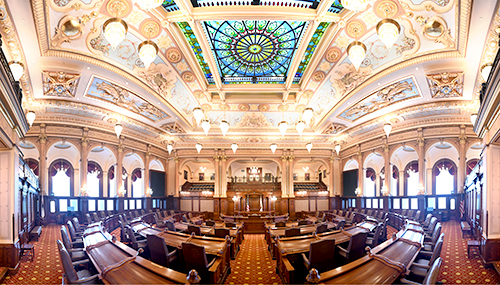 FRANKFORT – State Senator Michael E. Hastings (D-Frankfort), chair of the Senate Energy and Public Utilities Committee, oversaw a hearing Thursday on legislation that would put hundreds of thousands of union laborers to work building a 100 percent clean energy economy in Illinois.
FRANKFORT – State Senator Michael E. Hastings (D-Frankfort), chair of the Senate Energy and Public Utilities Committee, oversaw a hearing Thursday on legislation that would put hundreds of thousands of union laborers to work building a 100 percent clean energy economy in Illinois.
“As chair of the Senate Energy and Public Utilities Committee, I have had the distinct privilege of visiting with the hard-working men and women who help power Illinois,” Hastings said. “Moreover, I am one of the few in Illinois and in the country who has visited every nuclear generating facility in our state. Those who work in this industry take pride in all they do, coming from all walks of life. Their passion, hard work, and profession should not, and will not, be overshadowed by the dark cloud cast by a greedy few.”
Senate Bill 1100, the Climate Union Jobs Act would create and save an estimated 280,000 jobs and provide over $150 million annually in rate relief to low-income families, in addition to:
- Preserving the state’s nuclear fleet and other renewable generation
- Establishing new accountability and transparency requirements for utility companies
- Creating a just transition for communities economically reliant on fossil fuel generation and establishes equity requirements for clean energy jobs
- Reducing the state’s emissions from buildings and transportation
- Setting union labor standards when Renewable Portfolio Standard, Carbon Mitigation and Solar for All credits are used.
“As a legislative body, in a collective and inclusive manner, we must address the immediate threats that face our state,” Hastings said. “Today, we continued to examine these threats, hearing from passionate advocates from both sides of the energy industry. I want to thank them for their hard work, dedication, and investment in Illinois’ clean energy future. I look forward to the culmination of all our hard work and the passage of a piece of legislation we can all be proud of.”
The Senate Energy and Public Utilities will continue to meet in the following weeks to chart the course for the future of Illinois’ clean energy infrastructure.













 © 2025 Illinois Senate Democratic Caucus
© 2025 Illinois Senate Democratic Caucus